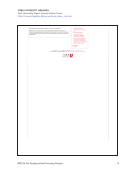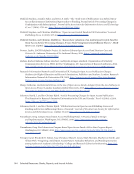31 SPEC Kit 353: Funding Article Processing Charges
Since we pay subscription fees for these journals from the collections budget and the OA fund also
comes from the collections budget, paying for articles in hybrid journals is essentially paying twice for
the same content. Also, there is no transparency and no obligation on the part of these publishers to
lower subscription fees in proportion to the APC fees they collect.
The HOPE fund is our implementation of the Compact-for-Open-Access-Publishing-Equity, through
which we carry out our mission to underwrite reasonable publication charges for articles published by
faculty and researchers in all-open-access journals.
The Open Access Fund is a program to support our scholars who wish to make their journal articles
openly available immediately upon publication, and to support gold open access publishers around
the world.
The purpose of the fund is to increase OA and full OA publishing and articles/books must be fully
available open access at time of publication. It is also to prevent large commercial academic publishers
from co-opting the Gold OA model by charging exorbitant APCs.
They do not contribute to the goals of open access.
We changed our policy during FY15 to suspend support for hybrid journals. We support fully open
access publications.
We consider it “double dipping.” Seeing as we already paying subscriptions to the journals, we are not
seeking to fund their open fees as well. We also want to discourage the hybrid model and therefore
won’t support it.
We did until 2015 decision to stop was partly budgetary, partly philosophical.
We don’t consider the hybrid model a good practice to support. “Double dipping,” or paying twice for
the same content, would hurt our budgets even more.
We don’t want to support publisher “double dipping,” and do want to encourage alternative business
models that are fully open access for the reader.
We prefer to direct our support to publishers of fully open access journals, rather than those who are
simultaneously charging authors for open access and libraries for subscriptions.
We want to incentivize publishing in, and support for, fully OA journals.
We wanted to support fully open access journals first.
If yes, do your guidelines require that the publishers reduce institutional subscription fees? N=4
Yes 1 25%
No 3 75%
30. Do your guidelines require that journals be listed in the DOAJ (Directory of Open Access
Journals) or other OA registry in order to be eligible for APC funding? N=33
Yes 25 76%
No 8 24%
31. Do your guidelines require that publishers be members of OASPA (Open Access Scholarly
Publishers Association) or adhere to a similar code of conduct to be eligible for APC funding? N=33
Yes 21 64%
No 12 36%
Since we pay subscription fees for these journals from the collections budget and the OA fund also
comes from the collections budget, paying for articles in hybrid journals is essentially paying twice for
the same content. Also, there is no transparency and no obligation on the part of these publishers to
lower subscription fees in proportion to the APC fees they collect.
The HOPE fund is our implementation of the Compact-for-Open-Access-Publishing-Equity, through
which we carry out our mission to underwrite reasonable publication charges for articles published by
faculty and researchers in all-open-access journals.
The Open Access Fund is a program to support our scholars who wish to make their journal articles
openly available immediately upon publication, and to support gold open access publishers around
the world.
The purpose of the fund is to increase OA and full OA publishing and articles/books must be fully
available open access at time of publication. It is also to prevent large commercial academic publishers
from co-opting the Gold OA model by charging exorbitant APCs.
They do not contribute to the goals of open access.
We changed our policy during FY15 to suspend support for hybrid journals. We support fully open
access publications.
We consider it “double dipping.” Seeing as we already paying subscriptions to the journals, we are not
seeking to fund their open fees as well. We also want to discourage the hybrid model and therefore
won’t support it.
We did until 2015 decision to stop was partly budgetary, partly philosophical.
We don’t consider the hybrid model a good practice to support. “Double dipping,” or paying twice for
the same content, would hurt our budgets even more.
We don’t want to support publisher “double dipping,” and do want to encourage alternative business
models that are fully open access for the reader.
We prefer to direct our support to publishers of fully open access journals, rather than those who are
simultaneously charging authors for open access and libraries for subscriptions.
We want to incentivize publishing in, and support for, fully OA journals.
We wanted to support fully open access journals first.
If yes, do your guidelines require that the publishers reduce institutional subscription fees? N=4
Yes 1 25%
No 3 75%
30. Do your guidelines require that journals be listed in the DOAJ (Directory of Open Access
Journals) or other OA registry in order to be eligible for APC funding? N=33
Yes 25 76%
No 8 24%
31. Do your guidelines require that publishers be members of OASPA (Open Access Scholarly
Publishers Association) or adhere to a similar code of conduct to be eligible for APC funding? N=33
Yes 21 64%
No 12 36%
























































































































































